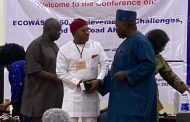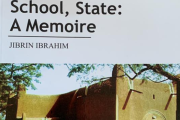By Adagbo ONOJA
The provocation for this irregular series mapping what each of the dominant cultural identities has brought to the diversity-crisis nexus in Nigeria has already been located in Chido Onumah’s claim in his latest book that We Are All Biafrans. We Are All Biafrans is his own way of saying that every other group is claiming and protesting marginalisation and that it behoves looking at the claims before it is too late. That makes all of us Biafrans in terms of a rejectionist discourse of the Nigerian State and the implication of that for state survival. And it turned out that it was at the launching of that very book that Atiku Abubakar, former Vice-President opened what came to be a Pandora’s Box on restructuring. That debate is still raging. We have been told that President Buhari might be the last president of Nigeria if there is no restructuring. We have heard that before though.

Ahmadu Bello, the late Sardauna of Sokoto and Premier of the defunct Norther Region

Alhaji Shehu Shagari,President of Nigeria in the Second Republic

Muhammadu Buhari,incumbent Nigerian President

Sultan of Sokoto

Prof Jubril Aminu, absolves Fulanis of violence completely
The first in this series, an effort to apply Onumah’s framework to selected identity groups, was the piece titled “The Igbos: Why are they Still Biafrans?” In this piece, I want to look at the recent upsurge of herdsmen violence, whether it could be the Fulani model of being Biafrans or a false claim against a historically dominant minority. A historically dominant minority is what Professor Peter Ekeh calls the Fulanis in Nigerian politics.
Herdsmen violence, Isawa Elaigwu, emeritus professor of comparative politics, told this newspaper in a lengthy interview recently, could be the eve of a civil war. His easy to follow argument is that it makes other groups to resort to self help efforts. The implication is that the state is challenged as far as monopoly of legitimate use of violence is concerned. Before Elaigwu spoke, communities in Benue, Enugu and parts of South-West were dead certain that the herdsmen behind the violence in their communities are of Fulani origin. Leaders of some of such communities who gave testimonies at the Seventh Tajudeen Abdulraheem Memorial on May 25th, 2016 provided the evidence to buttress their claims. However, Muhammad Sa’ad Abubakar, the Sultan of Sokoto and Professor Jubril Aminu have come out to challenge the Fulani identity of the violent herdsmen. They emphasised the old conception of Fulani herdsmen as the ultimate Pan-Africanists: moving across Africa, from Mali to Niger through Nigeria to Cameroon down to Central Africa, subjecting themselves to the authority of all the powers on their way and committed to no homeland claims.

The trademark cattle

Fulanis of the ‘exotic culture’

And now the sign of trouble
If, suddenly, this age old movement transforms into a situation that could be the signal for a civil war, then the most plausible question in the light of the thesis of We Are All Biafrans must be whether the herdsmen are being Biafrans in their own way.
By the Igbo and Niger Delta models of being Biafrans, the herdsmen violence would not qualify to be one. This is in the sense that there is no categorical declaration of animosity against the state. However, the theorists of We Are All Biafrans did not absolutise a categorical declaration of animosity as the definitive feature of Biafranist behaviour. What is thereby suggested is that such a declaration is not absolutely necessary before an action can be considered being Biafran on the part of any cultural group in Nigeria. Many other clues can provide the basis for the inference.
In the case of the Fulani, there has been a long history of grumbling that can be read in context. The loud grumbling is that substantial number of the Fulanis do not benefit from the government. They do not ask for any amenities such as hospital, roads, schools or markets. An attempt to take the benefits to them through the policy of nomadic education does not seem to have been any success. Two, they have basically lost their language. They are not the only cultural groups to have suffered this consequence of ‘CNNisation’ of the universe and it is not the fault of the government that this has happened but they are most likely to feel the pain more than many others. For an ethnic group which admits you only if you can speak the language, it cannot but be so. Three, their belief in their uniqueness, fuelled by some European testimonies, has been rendered inoperable by their more culturally and demographically expansionist Hausa brothers. In fact, the Nigerian press does not accept the possibility of Hausas and Fulanis as different ethnic identities. So, they have come up with the concept of Hausa-Fulani. But, who are the Hausa-Fulanis? What or whom does the concept refer to on the ground? Hausa-Fulani is not a tribe. There is nobody who answers to Hausa-Fulani as such. The sense invoked in its usage in the media in Nigeria is not the notion of people who have both Hausa and Fulani blood in them but people who are largely Muslims by religion. The implication here is the exclusion and disempowerment of Hausa-Fulanis who are not Muslims. As such, non Hausa-Fulanis such as Gwari, Nupe, Kanuri or Ebira are forced into membership of the Hausa-Fulani identity. As Muslims, such persons as IBB or the current Etsu Nupe would be regarded as Hausa-Fulanis in the Nigerian press usage of the concept but not Professor Adamu Baike or the late Professor Ishaya Audu, for examples. Those ones are Christian Hausa-Fulanis. And Christian Hausa-Fulanis are there in places such as Gwarzo in Kano, Malumfashi and Funtua in Katsina State, to mention a few. Of course, the case of the Bamagujes in Kano is well known.
The Hausa- Fulani discourse appear to be more about north – south power struggle than anything else, a convenient but amorphous concept which disciplines the region by securitising a group that doesn’t quite exist the way it is imagined. It doesn’t quite exist because the Muslim connotation about it distorts what it signifies or suggests: those with both Hausa and Fulani blood in them. The Sardauna, for instance, did not have a Hausa blood in him. Yet, in the Nigerian press, he is the life patron of the Hausa-Fulani oligarchy, another of such interesting concepts.
Four, they face resistance from many other ethnic groups in the north for what Professor Moses Ochonu has conceptualised as ‘colonialism by proxy’, the historical process which privileged Fulani players in the prosecution of colonial warfare, attracting for them residual hatred for the viciousness of that process, both in Caliphate heartland such as Kano but particularly so in the Middle Belt, for example. So, they are perpetually under a kind of a blow back. They have tried to manage it. Even when one looks at the federal architecture of power today, one could see elements of it. Five, pulaco – the Fulani core of being which is about being courteous, calm but wise is hardly a selling attitude in a republic of ethnically assertive groups who suspect the Fulani of love of power and a tendency to settle down and install an emir anywhere and everywhere. Sixth, the Fulani lack the critical mass to be talked of in terms of historically dominant minority anymore in the wake of democratic rule.
At the Seventh Tajudeen Abdulraheem Memorial earlier mentioned, there was a specific elaboration of a specifically Fulani grudge. Mallam Sale Momale of the Pastoralist Resolve articulated the argument that herdsmen violence is a last resort by them against repression by the system. He specifically indicted a particular arm of the security agencies for ripping Fulani herdsmen off. This is an angle that frustration-aggression theorists might love to pursue further. In the meantime, the key question the whole herdsmen saga throws up must be why it is happening now. What is it that makes it possible to be happening now?
Framed this way, herdsmen violence becomes almost the same thing as Boko Haram in the sense that there are just too many theories purporting to explain Boko Haram. Some people say Boko Haram is Hausa-Fulani reification of the threat to make Nigeria ungovernable if Jonathan torpedoed the Rotation of Power pact. Others put it to Goodluck Jonathan’s government’s strategy of self prolongation in power. There was a memo on this position. There are those who argue that it is the handwork of Modu Sherriff, former governor of Borno State. Some security experts see it as a secondary consequence of Cold War and post Cold War conflicts in Somalia, Sudan, South Sudan and Libya, leading up to export of terrorism, insurgency and crime in other parts of Africa. One of such categorically asserted that Boko Haram in north eastern Nigeria is a product of the movement of radical fighters and weapons into West Africa from Sudan, Somalia and lately, Libya. It is equally believed in many quarters that Boko Haram is a CIA operation targeting Nigeria. There are as many theories as there are theorists.
Almost all these claims apply to the case of herdsmen violence, particularly the claim that it is Buhari’s strategy of power. In the context of Buhari’s anti-corruption war amidst a rather clumsy economics, it is not impossible that those he is pursuing have crafted this particular theory. General Buhari appears ideologically lonely to connect to anything of this nature. That is if he is not overwhelmed too.
However, no theory may be thrown away. All theories must be thoroughly examined and accounted for, including those that says, for instance, that the whole idea of herdsmen violence is an Igbo orchestration by which they are responding to their being out of federal power for the first time since independence. As the theory goes, the Igbos were part of the government in the First Republic, central to the 1966 coup, fought the war, were central to the Second Republic, were the corner stone of the Jonathan regime but only to miscalculate in the case of Buhari and to find themselves as political outsiders of the regime. Elsewhere, the argument is that what is going on as Fulani herdsmen violence is an underground criminal movement that transcends one ethnic, religious or geographical identity but a relay system which could sometimes encase different ethnic elements, from a Fulani herdsman, a Hausa butcher, a Yoruba transporter and an Igbo trader acting out criminality in a chain.
What the multiplicity of claims and counter claims regarding herdsmen violence suggests is its complexity. It is a complexity that requires more than a yes or no kind of analysis. Rather than yes or no, it is Nigeria’s wizardry in conflict management that is challenged in terms of what weight to assign to each of the claims, those to then dismiss and those to examine more critically. In other words, a categorical answer to the question of whether recent herdsmen violence in Nigeria is Fulani model of being Biafrans or a false allegation against them can only be a work in progress, just yet. Any matter that can lead to any sort of war must be treated so.





























1 Comments
Generic doctor
Great internet site! It looks really expert! Keep up the
helpful job! https://www.youtube.com/watch?v=vIJzPyBZiQA